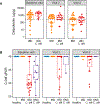Multi-omic Analysis of the Interaction between Clostridioides difficile Infection and Pediatric Inflammatory Bowel Disease
- PMID: 32822584
- PMCID: PMC9332131
- DOI: 10.1016/j.chom.2020.07.020
Multi-omic Analysis of the Interaction between Clostridioides difficile Infection and Pediatric Inflammatory Bowel Disease
Abstract
Children with inflammatory bowel diseases (IBD) are particularly vulnerable to infection with Clostridioides difficile (CDI). IBD and IBD + CDI have overlapping symptoms but respond to distinctive treatments, highlighting the need for diagnostic biomarkers. Here, we studied pediatric patients with IBD and IBD + CDI, comparing longitudinal data on the gut microbiome, metabolome, and other measures. The microbiome is dysbiotic and heterogeneous in both disease states, but the metabolome reveals disease-specific patterns. The IBD group shows increased concentrations of markers of inflammation and tissue damage compared with healthy controls, and metabolic changes associate with susceptibility to CDI. In IBD + CDI, we detect both metabolites associated with inflammation/tissue damage and fermentation products produced by C. difficile. The most discriminating metabolite found is isocaproyltaurine, a covalent conjugate of a distinctive C. difficile fermentation product (isocaproate) and an amino acid associated with tissue damage (taurine), which may be useful as a joint marker of the two disease processes.
Keywords: Clostridioides difficile; Gram-positive; inflammatory bowel disease; isocaproate; isocaproyltaurine; metabolome; microbiome; taurine.
Copyright © 2020 Elsevier Inc. All rights reserved.
Conflict of interest statement
Declaration of Interests The authors declare no competing interests.
Figures






Comment in
-
Clostridioides difficile: Sometimes It Pays To Be Difficult.Cell Host Microbe. 2020 Sep 9;28(3):358-359. doi: 10.1016/j.chom.2020.08.010. Cell Host Microbe. 2020. PMID: 32910918
References
-
- Altschul SF, Gish W, Miller W, Myers EW, and Lipman DJ (1990). Basic local alignment search tool. J Mol Biol 215, 403–410. - PubMed
Publication types
MeSH terms
Substances
Grants and funding
LinkOut - more resources
Full Text Sources

